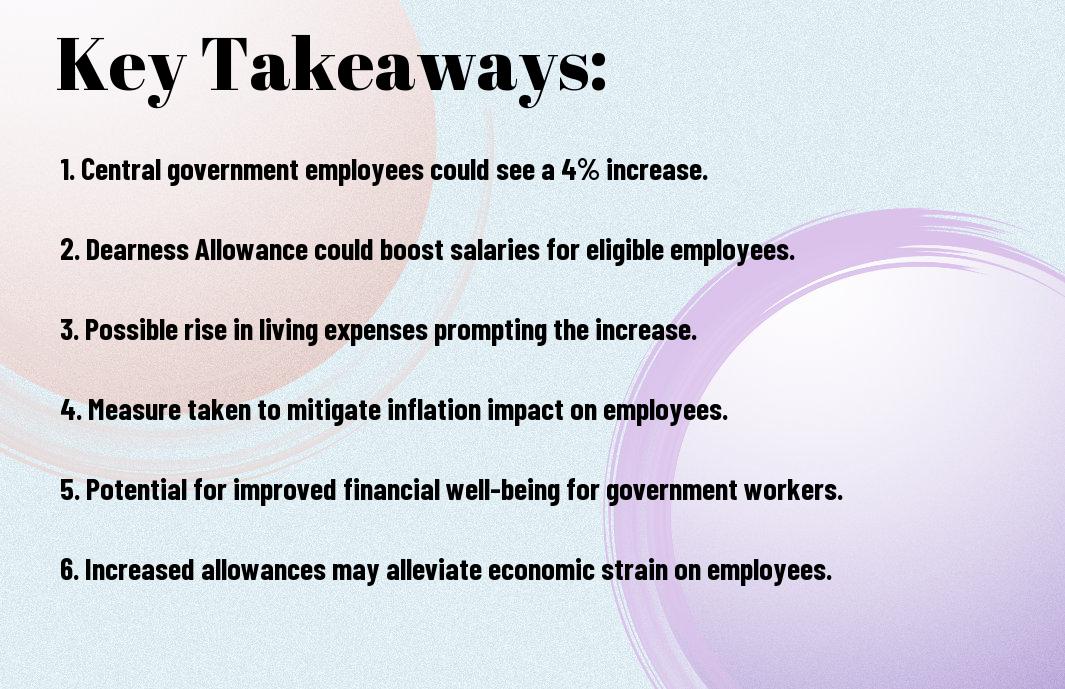Most central government employees are eagerly awaiting the 4% increase in Dearness Allowance set to come into effect soon. This rise will not only boost their salary but also help them cope with the rising cost of living. The Dearness Allowance hike is seen as a welcome relief for many employees who have been facing financial challenges due to inflation and increased expenses. This increase will have a significant impact on the monthly earnings of central government employees, providing them with some much-needed financial stability.

Understanding Dearness Allowance
You may have heard about Dearness Allowance (DA) in the context of government employees’ salaries, but what exactly is it and why is it important? Let’s explore into the details of Dearness Allowance and its significance.
Definition and Purpose
For government employees in India, Dearness Allowance is a component of the salary structure that aims to mitigate the impact of inflation on their earnings. It is adjusted twice a year, in January and July, based on the All India Consumer Price Index (AICPI) to ensure that employees can maintain their purchasing power amid rising prices. The primary purpose of Dearness Allowance is to provide relief to employees from the eroding effects of inflation on their standard of living.
Dearness Allowance is calculated as a percentage of the basic salary. As the cost of living rises, the Dearness Allowance percentage increases, thereby boosting the overall salary of government employees. This adjustment acts as a safeguard against the rising prices of important goods and services, ensuring that employees can meet their financial obligations effectively.
Historical Adjustments of Dearness Allowance
Dearness Allowance has been a part of the salary structure for central government employees in India since the 6th Pay Commission. Over the years, there have been significant fluctuations in the Dearness Allowance rates, with periodic increases and decreases based on economic conditions and inflation rates.
The fluctuation in Dearness Allowance rates reflects the dynamic nature of the Indian economy and the challenges posed by inflation. It is crucial for government employees to stay informed about these adjustments as they directly impact their take-home pay and financial well-being.
The adjustments in Dearness Allowance can have a substantial impact on the monthly earnings of central government employees, making it a vital component of their overall compensation package.

The Proposed 4% Increase
Context and Rationale Behind the Increase
Any increase in Dearness Allowance for central government employees is a topic of significant interest and importance. The proposed 4% increase comes in the wake of rising inflation and the impact of the COVID-19 pandemic on the economy. The government aims to provide relief to its employees by adjusting the Dearness Allowance to help them cope with the increased cost of living.
An imperative factor driving this increase is the regular revision of Dearness Allowance to compensate for the inflationary trends in the economy. By linking the Dearness Allowance to the Consumer Price Index, the government ensures that the purchasing power of its employees is maintained in line with the changing economic landscape.
Implications for Central Government Employees
Increase in Dearness Allowance directly impacts the take-home pay of central government employees, making it a crucial component of their overall compensation package. The proposed 4% raise will provide some relief to employees grappling with the increased cost of imperative commodities and services. This adjustment will help in maintaining the standard of living for government employees and their families.
With this increase, central government employees can expect a modest boost in their monthly earnings, which can contribute towards managing their expenses effectively. The adjustment in Dearness Allowance reflects the government’s commitment to supporting its workforce during challenging economic times, ensuring their well-being and financial stability.
Economic and Fiscal Impact
Now that the 4% increase in Dearness Allowance for Central Government employees is on the horizon, it’s imperative to consider the economic and fiscal implications of this decision.
Effect on Government Expenditure
Fiscally, the rise in Dearness Allowance will directly impact the government’s expenditure. As the DA is a component of the salaries of government employees, any increase automatically raises the government’s wage bill. With a large workforce under the Central Government, even a modest percentage increase can amount to a significant sum. This additional expenditure needs to be factored into the government’s budget, potentially affecting other areas such as infrastructure development or social welfare programs.
Moreover, the increase in Dearness Allowance can also have a cascading effect on pension payouts, as pension is often linked to the salaries of current employees. This double-edged impact further stretches the government’s finances, necessitating careful financial planning to ensure sustainability.
Potential Influence on the Broader Economy
An increase in Dearness Allowance can have broader economic implications beyond just government finances. The additional income in the hands of government employees can lead to a boost in consumer spending, which in turn can stimulate demand in the economy. This uptick in demand can have a positive effect on businesses, particularly in sectors catering to consumer goods and services.
For instance, increased spending by government employees can lead to higher sales for retailers, restaurants, and other service providers. This uptick in economic activity can contribute to overall economic growth, showcasing how decisions related to government salaries can have far-reaching consequences on the broader economy.
Comparing With Private Sector Adjustments
After the announcement of the upcoming 4% increase in Dearness Allowance for central government employees, many are wondering how this adjustment compares to the salary trends in the private sector. Let’s break down the key differences between the two to understand the impact on employees.
| Central Government Employees | Private Sector Employees |
| Receive regular increments based on Pay Commission recommendations | Salary adjustments often depend on company profits and performance |
| Uniform structure for salary increases across different departments | Varying pay scales and benefits based on industry and company policies |
| Dearness Allowance increases linked to inflation rates | Performance bonuses and incentives linked to individual or team achievements |
Salary Trends in the Private Sector
Sector salary trends in the private sector have been fluctuating in recent years due to economic factors and industry demands. While some sectors have seen significant growth in salaries, others have struggled to keep up with the rising cost of living. This disparity can lead to disparities in employee satisfaction and retention rates.
Sector Moreover, the private sector often offers more flexibility in terms of salary negotiations and benefits packages. Companies may tailor their compensation plans to attract and retain top talent, offering perks such as performance-based bonuses, stock options, and health benefits that may not be available to central government employees.
Dearness Allowance Versus Private Sector Benefits
For central government employees, the Dearness Allowance serves as a crucial component of their overall compensation package, helping them cope with inflation and rising living costs. However, in the private sector, employees may have access to a wider range of benefits beyond basic salary increments, such as flexible work arrangements, professional development opportunities, and profit-sharing schemes.
Versus While the Dearness Allowance increase is a welcome change for central government employees, it is necessary to consider the holistic benefits offered by the private sector when comparing overall compensation packages. Employees must weigh the stability and structure of government salaries against the potential for higher earnings and perks in private sector positions.
To wrap up
Presently, central government employees are eagerly anticipating a salary boost with the expected 4% increase in Dearness Allowance. This increase will provide some relief to employees facing rising inflation and living costs. While the increase is a positive development, it is important for employees to continue monitoring any future announcements regarding their salaries and allowances. As the government navigates through economic challenges, employees should stay informed and prepared for any changes that may impact their finances. Overall, the upcoming increase in Dearness Allowance is a step in the right direction for supporting central government employees in maintaining their standard of living.

